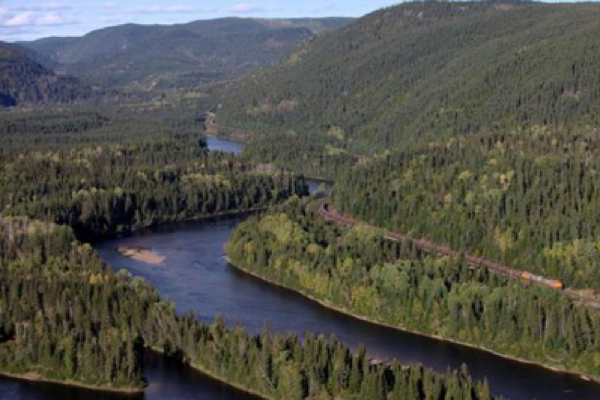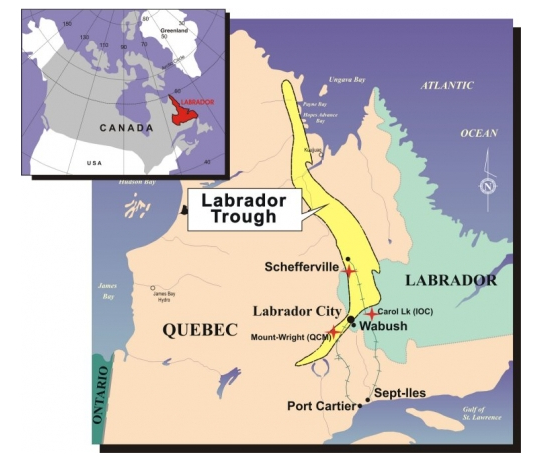TIL: Titanium used for Mach3+ Cold War spy plane came from Russia |
- TIL: Titanium used for Mach3+ Cold War spy plane came from Russia
- How Ecuador could make money on the Goldman Sachs gold deal
- Quebec commits up to $20 million for new Labrador Through rail line
- STOP LOSS: Iron ore price recovers 3% for the week
- US start-up ready to sell lab-made rare earths
| TIL: Titanium used for Mach3+ Cold War spy plane came from Russia Posted: 07 Jun 2014 01:59 PM PDT  Image: Nasa The Blackbird is the world's fastest plane capable of speeds reaching 2,200mph (3,540kph) while its futuristic shape and black paint full of radar-absorbing iron made it virtually undetectable. The SR-71, built by Lockheed, served with the US Air Force from 1964 to 1998. A total of 32 of the reconnaissance aircraft were built while 12 were lost in non-combat accidents. According to military data the plane cost $85,000 per hour to operate. One of the interesting tidbits from the interview with Colonel Rich Graham who spent 15 years as a Blackbird pilot and wing commander was that the Soviet Union actually helped build the Blackbird: "The airplane is 92% titanium inside and out. "Back when they were building the airplane the United States didn't have the ore supplies – an ore called rutile ore. It's a very sandy soil and it's only found in very few parts of the world. "The major supplier of the ore was the USSR. Working through Third World countries and bogus operations, they were able to get the rutile ore shipped to the United States to build the SR-71." Continue reading at BBC Future |
| How Ecuador could make money on the Goldman Sachs gold deal Posted: 06 Jun 2014 03:24 PM PDT 
New York investment bank Goldman Sachs this week picked up 466,000 ounces of gold from cash-strapped Ecuador's central bank. Goldman will give back the 1,165 gold bars, worth roughly $580 million at today's ruling price, in three years time according to the agreement inked with Banco Central del Ecuador. Ecuador is struggling with a record deficit and the central bank explained it "invested" the gold, about half the country's total reserves, with Goldman in exchange for more liquid assets. The bank, which lost its autonomy when self-confessed socialist revolutionary President Rafael Correa took office in 2007 expects to turn a profit of as much as $20 million on the transaction. In November last year Venezuela came close but in the end walked away from a similar deal with New York investment bank. Correa, a three-term president was a close ally of late Venezuelan president Huge Chavez. The central bank explained the rationale for the deal it professes is "safe, liquid and profitable" in a statement this way: Gold that was not generating any returns in the bank's vaults and attracted storage costs. The gold "now becomes a productive asset that will generate profits. These interventions in the gold market represent the beginning of a new and permanent strategy of active participation by the bank, through purchases, sales and financial operations, that will contribute to the creation of new financial investment opportunities." The transaction has puzzled many gold market participants if not most official sector economists. Writing in Fortune magazine, Stephen Gandel, tried to figure out how Ecuador can generate such a handsome return on investment: A gold swap is pretty close to a collateralized loan. Goldman is essentially lending Ecuador money for three years, and taking its gold as collateral. Typically, you pay interest or a fee for a loan like that. Venezuela said its $1.8 billion gold swap was going to cost $800 million in financing over seven years. Based on that, Ecuador could be paying Goldman a little over $100 million for its swap. On top of that, Ecuador would end up owing Goldman even more money if the price of gold rises over the next three years. But there are a few ways Ecuador could end up making $20 million on the deal. Ecuador could be betting that the price of gold will fall 20% over the next three years. Another way would be for Ecuador to take the cash it gets from the swap and invest it elsewhere in something that will make 20% over the next three years, not an easy task given that the average bond is yielding just 1.8%. Or Ecuador could have done another swap, this time with the dollars it received from Goldman for Ecuadorian bonds. It would, of course, have to pay Goldman another fee for that. But that swap would pay the spread between U.S. three-year interest rates at about 0.85%, and Ecuadorian interest rates, which are around 7% or 8%, or a little over 20% during the three years. The last option sounds like a sure-fire way for the central bank to make money on the deal, says Gandel. Unless Correa does what he did five years ago: Orchestrate a de facto bond default (by declaring intention not to pay, waiting for prices to tank and then buying back the bonds on the cheap). Click here to continue reading at Fortune. Image of President Rafael Vicente Correa Delgado from the Presidency's Flickr feed. |
| Quebec commits up to $20 million for new Labrador Through rail line Posted: 06 Jun 2014 12:12 PM PDT  One of two existing railways in the Trough, the Quebec North Shore and Labrador line runs a 418-kilometre route between Labrador City and Sept-Isles. Iron ore mining in the Labrador Trough region of Canada has been a hard sell as of late, but the Quebec government's commitment of up to $19.2 million ($Cdn 20 million) for a feasibility study on a new rail link that would connect mines in the area to ports, may be about to change that. The funding, announced as part of this week's provincial budget, will back up a study to estimate costs and define the best railway option, including boosting capacity on current lines and the construction of a new one. While the 1000-kilometre-long area —home to one of the world's largest high-quality iron-ore deposits— seems attractive to miners, they are not jumping from joy on the news. There still are uncertainties in the market, such as current prices sinking close to two-year lows and the fact some miners have been either shelving projects in the region or having difficulties selling them. Rio Tinto (LON:RIO) failed to find last year a buyer for its 59% stake in Iron Ore Company of Canada (IOC) and Cliffs Natural Resources (NYSE:CLF) said in mid-February it was shelving an expansion of its Bloom Lake mine in the region. On top of that, the Canadian National Railway (CN) last year shelved a feasibility study for the construction of a $5 billion rail line and terminal handling facility to serve Labrador Trough, citing adverse market conditions. Currently there are only two rail lines in the area operated by ArcelorMittal (NYSE:MT) and IOC.
"They were distressed assets before with a high cost of infrastructure and a falling iron ore price. A new rail link would make the assets much more economic," Champion chairman Michael O'Keeffe said in a statement Friday. He added there is a high level of interest in the Labrador Trough as the world's major steel industry groups already see the potential of the region to supply high quality iron ore product. With an annual production estimated in 50 million tonnes, a wide range of listed and private iron ore miners are currently active in the region, including ArcelorMittal and Rio Tinto have assets in the region, and WISCO, Mitsubishi, Posco, Tata Steel, Cliffs Natural Resources, Alderon Iron Ore, China Steel and Hebei Iron & Steel, Labrador Iron Mines, and Champion Iron. Map courtesy of Labrador Iron Mines. Image by Melissa King |
| STOP LOSS: Iron ore price recovers 3% for the week Posted: 06 Jun 2014 12:08 PM PDT Benchmark iron ore gained slightly on Friday, with the steelmaking raw material notching up its first weekly gain in eight. According to data from the The Steel Index, the import price of 62% iron ore fines at China's Tianjin port rose to $94.50 per tonne on Friday, up $0.20 on the day. Recent gains come on the back of rising steel and futures prices in Asia. The world's most active steel contract, Shanghai rebar, jumped 1%, while iron ore futures and swaps traded in Singapore for July delivery jumped $0.75 to $95.25. The iron ore price is up nearly 3% since last Friday when it was trading at its lowest level since September 2012, but the commodity remains some 30% below levels at the start of year. The weakness in iron ore in 2014 is blamed on expectations of a glut on markets just as demand from China, responsible for two-thirds of the 1.2 billion tonne seaborne trade, cools. But the one-fifth drop in value over just the last couple of months may have been overdone: Iron ore has not trade below $100 on a quarterly basis since 2009 and when prices stay below this level for long enough high cost mines, particularly those in China, become unprofitable leading to cuts in supply. During the September 2012 slump down to $86.70, number two producer Rio Tinto estimated as much as 100 million tonnes output were taken off the table, which pushed prices back up. Iron ore only traded below $100 a tonne for just over a fortnight during the last downcycle and ended that year north of $150. So far in 2014 iron ore has average $114.34 a tonne. A complicating factor in 2014 may the popularity in China of using commodities – particularly iron ore and copper – as collateral for trade credit. Stockpiles of imported iron ore at Chinese ports are at record highs above 110 million tonnes according to industry consultancy Steelhome, up more than 50% from this time last year. Some estimates put the portion of iron ore inventories that is used as collateral for short term loans at 40%, but Beijing is cracking down on the practice as it tries to rein in the country's vast shadow banking system and tackle excessive debts in the economy. Beijing's tightening of controls coupled with a weakening yuan – another deliberate move by authorities – are pushing these deals under water and much of that ore could find its way back onto the market creating a vicious circle. Iron ore deals are also being targeted to reduce chronic overcapacity in China's steel industry and in the process tackle polluting sintering plants and blast furnaces. |
| US start-up ready to sell lab-made rare earths Posted: 06 Jun 2014 10:11 AM PDT Infinitum, a Massachusetts-based start-up engaged in clean metal production processes, is gearing up to launch its first products made with a proprietary anode technology that can reduce energy consumption and emissions. While the company's approach can be used to produce other metals, including magnesium and aluminum, Infinitum said it is starting with rare earths because they currently fetch much higher prices. According to Phys.org, the first two metals to hit the market are neodymium and dysprosium, needed to make powerful magnets that work at high temperatures. The firm's executives say that, while their proprietary process can reduce processing costs of metals such as aluminum and magnesium by 30 to 50%, the figure is not that clear when it comes to rare earths. This because it doesn't address pollution from mining and separating rare earth oxides from other materials in the ore. |
| You are subscribed to email updates from MINING.com To stop receiving these emails, you may unsubscribe now. | Email delivery powered by Google |
| Google Inc., 20 West Kinzie, Chicago IL USA 60610 | |


0 Comment for "TIL: Titanium used for Mach3+ Cold War spy plane came from Russia"